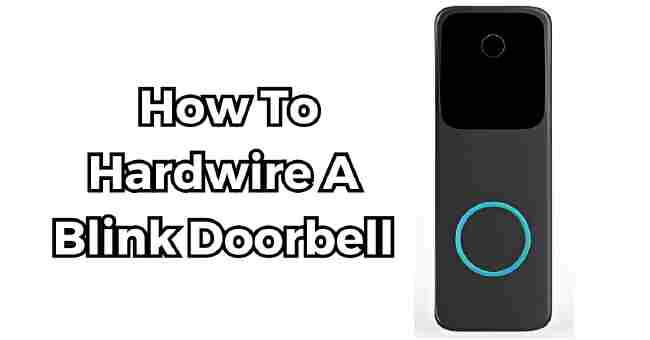Table of Contents
Do you wish to know how to hardwire a blink doorbell and stop the frustrations of a battery-powered Blink doorbell dying at the worst times? I sure do.
My old Blink would constantly stop recording due to drained batteries. Just as a delivery arrived or unexpected guest appeared—blackout.
The neighbourhood cat could nap on my welcome mat for hours unseen. Once I even missed an important visitor because my Blink missed everything.
Not fun when you’ve paid good money for a security camera.
After yet another exasperating blackout, I finally decided enough’s enough. I couldn’t keep waiting weeks for support to ship replacement batteries either. There had to be a better way to power my Blink.
That’s when I discovered hardwiring a Blink doorbell for continuous, reliable power.
This comprehensive DIY guide takes you through every step – from assessing your existing setup to troubleshooting problems after install.
I’ll share wiring diagrams, mounting tips, integration instructions, and more to turn you into a Blink hardwiring expert.
Let’s wire up that sleek new Blink and unlock its full capabilities.
The Benefits of Hardwiring Your Blink Doorbell
Before we dig into the installation process, let’s look at why hardwiring your Blink is worthwhile:
- You’ll never miss an event again. Hardwired Blink doorbells receive continuous power, allowing them to actively monitor your front porch 24/7. No more brief blackout periods with drained batteries.
- Enhanced motion detection. With uninterrupted power, your Blink’s motion sensor stays vigilant at all times. Anything that moves in sight of the camera promptly triggers an alert.
- Higher quality night video. Low-light footage clarity receives a boost when your doorbell no longer has to conserve battery reserves.
- Faster notifications. Hardwired Blinks deliver notifications with less delay since background functions aren’t periodically inactive.
- Increased reliability. Bypassing batteries means one less component prone to failure over time. Your wired Blink remains online come rain or shine.
Let’s look at what you’ll need to reap those rewards:
What You Need Before Starting
Hardwiring your Blink Video Doorbell requires just a few supplies. Here is a checklist of must-haves:
- Blink video doorbell system
- Existing low-voltage wiring with transformer
- Basic wiring tools:
- Screwdrivers
- Wire cutter/stripper
- Voltmeter
- Ladder (for high doorbell locations)
- Patience and some time!
- (Optional) Smart assistant like Alexa or Google Assistant for full functionality
The key requirements are existing doorbell wiring and access to a transformer that converts high-voltage AC power into low-voltage DC usable by your Blink unit.
I’ll go over identifying suitable wiring and transformers later when assessing your setup. First, let’s tackle the prep work.
Assessing Your Existing Doorbell Setup
Hardwiring a video doorbell like the Blink Video Doorbell 2 borrows power from your existing doorbell system. To plan your wiring approach, we’ll need to inspect that setup.
Here’s how:
1. Shut off the power supply
Find the electric circuit breaker that controls your doorbell and turn it OFF. We don’t want live wires shocking anyone! For door chimes receiving power from a transformer rather than the main lines, unplug the transformer instead.
2. Remove the current doorbell
Take out your old wired doorbell button and mounting plate if present. We need full access to those wires coming out from behind your wall.
3. Identify the wires
There are usually just two wires:
- Front – Carries the low-voltage power to the doorbell
- Trans – Returns power back from the doorbell to the transformer
4. Verify wiring voltage
Use a voltmeter to check voltage. Place one probe on each wire to measure across them. You want 16-24 VAC. Any less could cause problems later when powering your Blink.
5. Inspect the transformer
If you have an older home, locate the transformer typically nearby or inside the doorbell chime box.
It will connect to your doorbell wires to step 120+ VAC down to ~16-24 VAC. Ensure it has sufficient VA (volt-amps) to support your video doorbell. Rating should be at least 10 VA but 30+ VA is better.
Got a modern transformerless setup? Then power comes directly from your interior wiring at ~16 VAC already.
Either way, verifying voltage and transformer capacity prevents low power issues down the road.
Okay, we have sized up the wiring and power supply. Now we can install your new Blink wired doorbell starting by removing old components.
Carefully Removing Your Old Doorbell
With the power off, let’s get rid of the outdated wired doorbell if you have one:
1. Unmount doorbell and plate
Remove any screws or bolts fixing it place. Carefully detach both doorbell button and mounting plate from the wall.
2. Cut away old wires
Clip back the existing doorbell wires so new wire ends are exposed for connecting your Blink device later.
3. Clean surface
Use sandpaper to smooth doorbell mounting area, then wipe clean. We want a pristine foundation for installing our cutting-edge Blink next.
And that’s it! With outdated doorbell removed and wires prepped, we are ready to wire up our new smart video doorbell.
Time for the fun part.
How to Hardwire a Blink Doorbell: Connecting the Blink Wires
Here is a step-by-step guide to wiring your Blink Video Doorbell including diagrams:
1. Ensure power is still OFF!
I’ll say it again – make absolutely sure power is OFF at the circuit breaker/transformer before doing any wire work.
2. Identify wires
Use a voltmeter to determine the front and trans wires if you haven’t already.
3. Prepare wires
Strip back insulation using wire cutters to expose clean copper ends. Ensure no loose strands.
4. Connect front wire
Attach your existing doorbell’s front wire to the ‘Front’ terminal on the Blink doorbell using a screwdriver.

Ensure connection is tight and secure. No loose strands sticking out.
5. Connect transformer wire
Now hook up the trans wire from your current doorbell or chime box to the ‘Trans’ terminal on Blink device:

Again, tighten securely with no loose pieces.
6. Neatly tuck wires into wall box
Use wire nuts if needed to cleanly bunch wires together so they pack neatly into wall box without stressing connections.
7. Turn power back ON
Re-enable power at circuit breaker or by plugging transformer back in.
Give your newly wired Blink 30 seconds to start up. The LED light ring will spin blue when ready.
Now we can put on the finishing touches by mounting the doorbell and finalizing setup.
Mounting Your Blink Doorbell
With electrical work completed, let’s physically install your wired Blink Video Doorbell:
1. Position camera properly
Ensure the camera lens has good line-of-sight to catch visitors face-on. Angling it slightly downwards usually works best.
2. Mount doorbell button
Place circular button on wall according to included template so visitors know where to push.
3. Allow slack in wires
Keep wires loosely coiled behind unit with plenty of slack. Taut wires risk deteriorated connections over time.
4. Attach to mounting plate
Screw doorbell securely onto included mounting bracket. This keeps it fixed in ideal position.
5. Test button
Press doorbell button to verify button press activates camera live view as expected.
We’re so close now! Just a bit more setup and you’ll have a fully functional hardwired Blink ready to guard your entryway.
Configuring Your Hardwired Blink
To finish setting up your wired Blink Video Doorbell 2, grab your mobile device and:
1. Sync with Blink app
In the Blink app, add the new doorbell to your account via the in-app flow. Make sure firmware is up-to-date too.
2. Connect doorbell to WiFi
Choose your home WiFi network and enter password so the doorbell can transmit notifications and video to the cloud.
3. Adjust settings
Customize preferences like motion sensitivity, notifications, live view duration etc. You have granular control over doorbell functionality.
4. Connect to voice assistant (optional)
For full smart home integration, link your Blink account to Amazon Alexa or Google Assistant. Then you can use handy voice commands.
Setup complete. Your hardwired Blink doorbell now guards your home with 24/7 power and maximum capabilities unlocked.
Of course, even seasoned DIY-ers can run into snags.
Troubleshooting Common Hardwire Issues
While the above guide works smoothly for most Blink doorbell installs, here are some common problems and fixes:
Low voltage at doorbell
What’s wrong: Voltmeter shows voltage below 16 VAC across wires
Fix: Upgrade transformer if too small. Shorten wire length. Increase wire gauge.
Can’t connect Blink to WiFi
Why: Weak router signal at doorbell location
Fix: Move WiFi router closer, add WiFi extender, run ethernet from router to doorbell
Video stops working
Reason: Wire came loose, lost connection to WiFi
Fix: Check wiring connections, reboot device, reconfigure WiFi
Not getting notifications
Cause: Motion Detection disabled, Do Not Disturb enabled
Solution: Enable Motion Detection, turn off Do Not Disturb
Stuck on another issue? First, triple check wiring and connectivity. Then reboot the doorbell and reset sync with Blink app.
If problems persist, contact Blink Support or consider hiring an electrician.
Assuming all now functions smoothly, let’s explore some advanced integrations…
Enhancing Your Hardwired Blink Doorbell
Completing basic installation unlocks major upgrades already over a battery-powered Blink. But we can take things further.
Connect to a Smart Home Hub
Linking your hardwired Blink Video Doorbell to a home automation hub like Samsung SmartThings or IFTTT enables automating actions based on doorbell presses.
For example, flash exterior lights when someone rings the bell after dark. Or have a voice assistant announce the visitor’s name using facial recognition. The options are endless.
Link with other Blink cameras
Create a unified perimeter security system by connecting your newly installed Blink doorbell with existing Blink outdoor and indoor cameras.
View all camera feeds in one dashboard and configure system-wide settings like custom motion zones.
FAQs
What Voltage Is Needed For Blink Doorbell?
To function optimally, the Blink Video Doorbell requires 16VAC to 24VAC supplied from low voltage wiring.
Anything below 16 volts can cause intermittent power issues. Thankfully most modern doorbell systems output 16VAC to 18VAC already. Older homes may need a transformer upgrade to boost volts.
Does Wired Blink Doorbell Need Battery If Hardwired?
Nope! Once your Blink doorbell camera is wired into an AC power source, the internal battery is bypassed completely.
The whole point of hardwiring is to provide continuous, uninterrupted power. Hardwired Blink units don’t even have a battery slot – the wiring handles all power needs.
Can Blink Doorbell Use Regular Batteries?
Unfortunately not. The Blink Video Doorbell and Video Doorbell 2 require a specialized lithium battery pack, specifically the Blink Video Doorbell Battery.
This proprietary battery clips into the back panel and charges wirelessly from the doorbell wiring.
You cannot substitute regular AA or AAA batteries. Only the custom Blink battery will work. Of course, wired Blink doorbells don’t need a battery at all!
How Does A Wired Doorbell Get Power?
A traditional wired doorbell receives low voltage AC power from the building’s electrical system.
Inside the walls runs 16VAC to 24VAC wiring that connects to a transformer. This steps down 120V household current to a safer level for the doorbell.
When someone presses the button, this completes the circuit allowing current to flow through and make the chime box emit its familiar ‘ding dong’ sound.
Modern video doorbells like Blink tap into the same wiring for power.
Can I Hardwire A Doorbell From A Light Switch?
Unfortunately light switches carry dangerous 120V household voltage, way too high for a doorbell.
Low voltage doorbell wiring is completely separate, even if it ultimately ties back to your breaker panel.
You’d have to run new low-voltage wiring from an outlet’s transformer to your proposed doorbell location.
This requires opening up walls and drilling holes – no easy feat. Easiest is to hardwire a video doorbell using existing wiring.
Can I Hardwire Any Blink Doorbell Model?
Currently only the second generation Blink Video Doorbell 2 supports hardwiring out of the box.
The battery-powered Blink Video Doorbell lacks terminals for connecting wires. Hardwiring would require splicing wires directly onto the circuit board – extremely challenging even for engineers!
So I only recommend wiring the Video Doorbell 2. Its clearly labeled hardwiring terminals make installation almost plug and play.
Do I Need A Sync Module With A Hardwired Setup?
Nope, you can happily use a hardwired Blink doorbell completely standalone. The Sync Module is only required for battery-powered Blink cameras to enable features like live view, capture clips, and custom zones.
Since a wired doorbell has constant power, it connects directly to WiFi to enable live streaming, notifications, clips and everything else.
So there’s no need to buy the Sync Module if your Blink doorbell is hardwired.
Does Blink Work With 220v?
Unfortunately not – Blink devices are designed solely for 110-120 volt 60 Hz power systems used in North America.
The 220-240 volt 50 Hz standard common in Europe, Asia and elsewhere exceeds Blink’s voltage limits.
A 220V to 120V step-down transformer could enable using Blink internationally. But you’d risk damaging the units if the adapter fails.
I’d strongly recommend buying a natively compatible video doorbell brand instead.
How Do I Know If My Doorbell Is 16v?
Verifying doorbell voltage requires a simple voltmeter test. First shut off doorbell power at the breaker.
Then disconnect wires and carefully place a voltmeter probe on each one. The reading across the two wires should show 16VAC to 24VAC if it meets Blink requirements.
Some advanced multimeters autodetect AC vs DC – otherwise note small V squiggle for AC volts.
If voltage shows lower than 16V, get a licensed electrician to inspect and upgrade wiring.
Is The Blink Doorbell Waterproof?
While Blink advertises their doorbells as weather resistant, the Blink Video Doorbell 2 carries an official IPX5 water resistant rating.
That means it can withstand low pressure water jets from any direction with no leakage. The batteries even recharge after getting wet!
So while I wouldn’t spray yours directly with a hose, the Blink Doorbell handles rain, snow, humid weather perfectly fine. No need to build an awning to protect your new Blink!
Hardwiring Tips and Conclusion
While straightforward for many DIY smart home owners, hardwiring a video doorbell can get complex fast.
Here are final tips to ensure ongoing success with your Blink:
- Regularly check wiring connections and inspect wires for deterioration
- Test doorbell monthly and check motion settings still fit usage patterns
- Sync firmware updates for latest features and bug fixes
- Don’t hesitate to call an electrician if you hit technical hurdles
Remember – this guide covers basics but can’t replace an electrician’s specialized technical skills.
When in doubt, consult a professional.
Overall, hardwiring your Blink Video Doorbell 2 unlocks huge benefits over standalone battery-powered models.
You’ll gain 24/7 recording, instant notifications, crystal clear night vision and increased reliability.
I hope following this DIY walkthrough gave you the confidence to safely install your Blink doorbell wired. You now have the ultimate smart security sentry guarding your home.




